What do U.S. paper sizes have in common
with the Earth and Moon?
by Michael S. Schneider

If we thought of it at all, what possible connection could there be between ordinary U.S. writing paper and the great Earth and Moon?
At first, it would seem to require too much of a stretch to even start thinking about such a preposterous amalgam.
But if we think of each in terms of their most simple dimensions, then it's not so far out a connection at all.
Let's start with what we know: The polar diameter of the Earth is 7920 miles (radius 3960 miles) and the Moon's diameter is 2160 miles (radius 1080 miles).
Since the ratio of their diameters is 7920/2160 = 3 & 2/3, the Earth's diameter is to the Moon's is the same, which is simply 11/3.
Since the Earth isn't a perfect sphere but nearly an oblate spheroid, it's not appropriate to apply perfect pi (3.14159...) to it.
Instead, we'll use the well-known traditional approximation of pi as 22/7 (or 3.14285...), which is distorted by less than two feet in a mile.
When the Earth and Moon's dimensions are considered with this value of pi, a curious mathematical situation occurs: a squared-circle!
Below, a green square has been drawn around the Earth with diameter 7920 miles.
The Moon has been brought down to Earth's surface. As it rolls around the Earth, the Moon's center leaves a circular blue trail.
The perimeter of the square around the Earth is 4 x 7920 = 31,680 miles.
The circumference of the blue circle is 2 x pi x radius = 2 x 22/7 x (3960 + 1080) = 44/7 x 5040 = 31,680 miles as well.
Thus this ideal description of the Earth and Moon "squares the circle" by producing an equal perimeter and circumference.

The radius of the blue circle, 5040 miles, is an interesting number itself, being equal to the numbers one through seven multiplied: 1 x 2 x 3 x 4 x 5 x 6 x 7 = 5040.
Extending this multiplication in an interesting way is that the Earth's diameter 7920 = 8 x 9 x 10 x 11.
Thus, the area of this blue circle = pi x radius squared = 22/7 x (5040 x 5040) = 2 x (1 x 2 x 3 x 4 x 5 x 6 x 7 x 8 x 9 x 10 x 11), double the numbers 1 through 11 multiplied together!
Another numerical coincidence is that the sum of the diameters of both Earth and Moon 7920 + 2160 = 10,080 is the same as the number of minutes in one week.
Still another happy coincidence is that 10,080 is a Highly Composite number with exactly 72 divisors, the same as the average number of heartbeats in one minute.
Below, left, we see some basic measures of this Earth-Moon relationship in miles.
Dividing each measure by 720 (= 1 x 2 x 3 x 4 x 5 x 6 = 8 x 9 x 10) we simplify them into the figures at center.
Note that the 31,680 mile perimeter of the green square and circumference of the blue circle, when divided by 720, must both be equal to 44 (= 4 X 11).
We thus find that the distance from the center of the Earth to the top of the Moon is to the Earth's diameter as 8.5 is to 11.
This is the ratio of sides of ordinary U.S. writing paper known as "Letter" size (in "landscape" orientation seen below, right).
This is the paper size familiar to most Americans, found commonly in our printers.

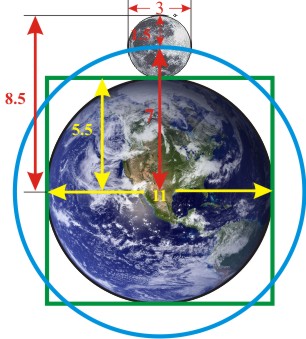
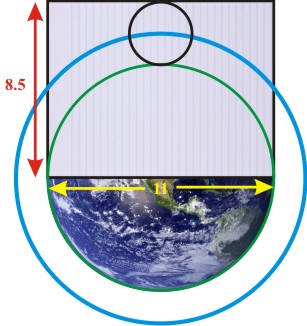
The American Forest & Paper Association explains the origins of Letter-size paper this way: "Back in the late 1600's, the Dutch invented the two-sheet mold.
The average maximum stretch of an experienced vatman's arms was 44".
Many molds at that time were around 17" front to back because the laid lines and watermarks had to run from left to right.
Sounds big?...well to maximize the efficiency of paper making, a sheet this big was made, and then quartered, forming four 8.5" x 11" pieces."
To see the dimensions of other U.S. paper sizes in this Earth-Moon squared-circle diagram we need to make it symmetric by showing Moons rolling around in the cardinal directions.
At right are some of its measures in miles:
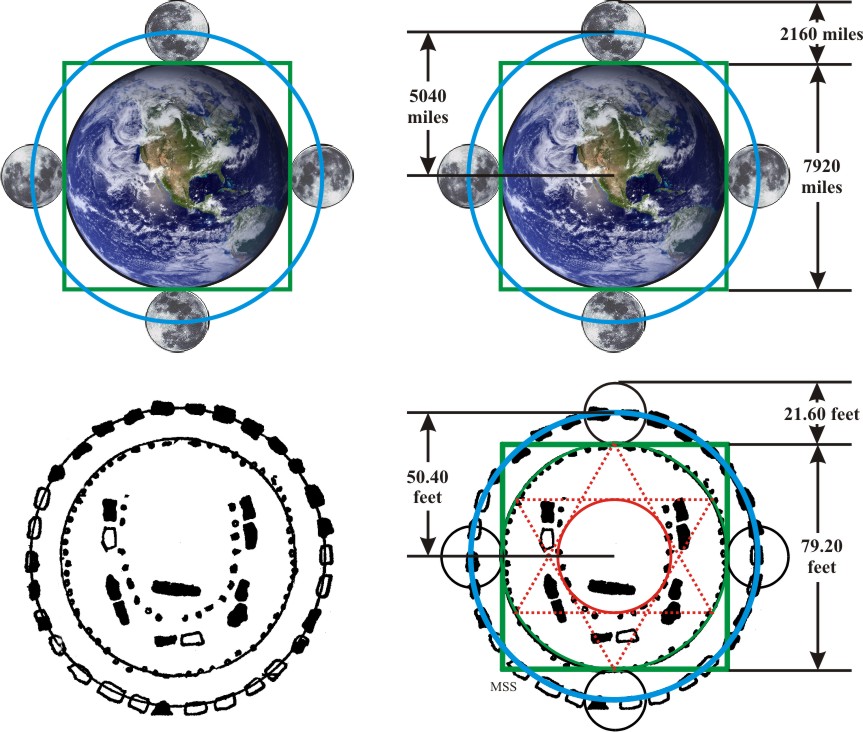
Most astonishingly, the plan of Stonehenge resembles this Earth-Moon scheme in miniature.
Its two concentric outer rings of stones relate by a "squared circle,"
and its measures reveal the same numbers but in feet instead of miles. What did they know?
Back to our investigation of paper, Letter-size paper in "Portrait" orientation can thus be seen this way:
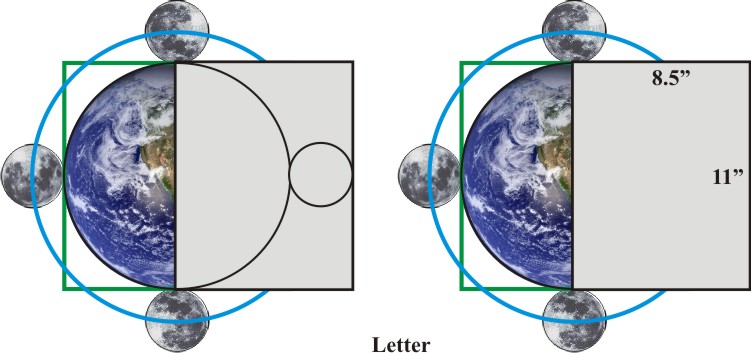
Another familiar paper size is called "Legal" and is most often seen in the form of yellow writing pads.
Its dimensions are 8.5 x 14 inches.
These too can be found in the dimensions of the Earth and Moon, where Legal paper's dimensions are found as follows:
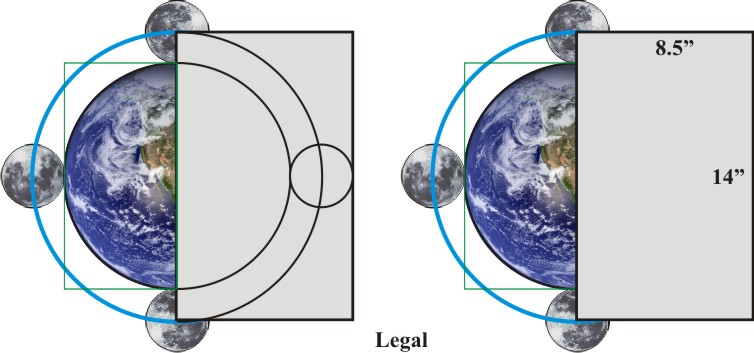
Even larger sizes known as Ledger and Tabloid can be found here too. They both are 11 x 17 inches, but used as Portrait and Landscape orientations.
This size is equal to two Letter-size sheets.
They are also both found in the relationship between the diameter of the Earth and the full distance between opposite Moons:
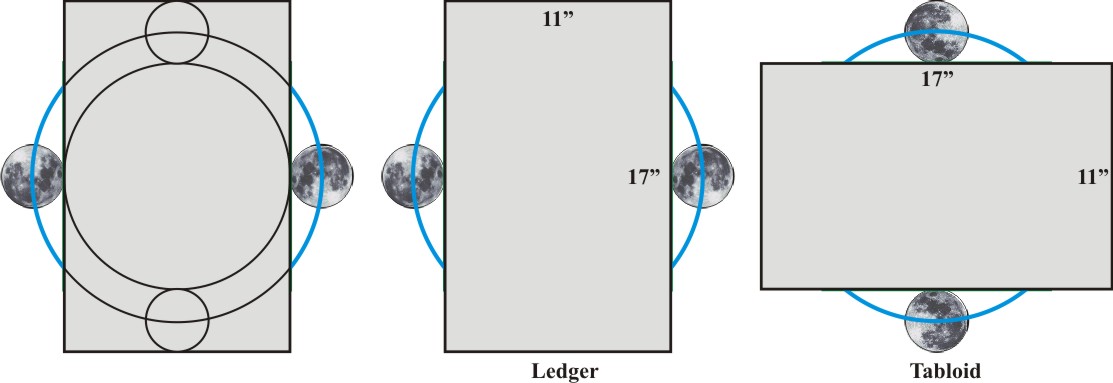
The curious mathematics of this squared-circle and its Earth-Moon relationship, along with the schemes of Stonehenge and more, has been written about extensively by my friend John Michell
(in his highly recommended books The Dimensions of Paradise and How The World Is Made) and by others.
It's to him that I dedicate this little investigation about writing paper (albeit American) but ones which derive from traditional times and measures.
If you'd like to learn more about these interesting numbers and how to construct this Earth-Moon relationship using a compass and straightedge,
you'll also want my Constructing The Universe Activity Book Volume 5 called "Constructing The Cosmological Circle: Symbol and Instrument for Universal Harmony"
available only through this website. Click here or on the picture for more information:

If you're interested in a Cosmological Circle T-Shirt, look here.
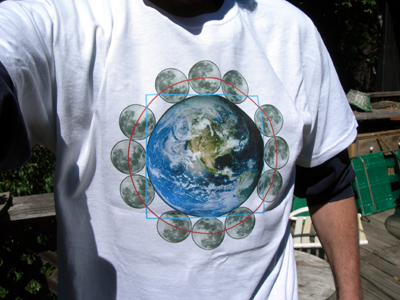
Constructing The Universe Home Page
Illustrations and Text (c) 2012 Michael S. Schneider











